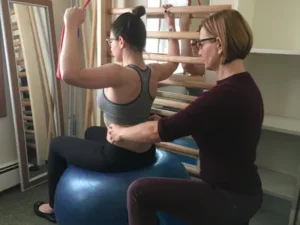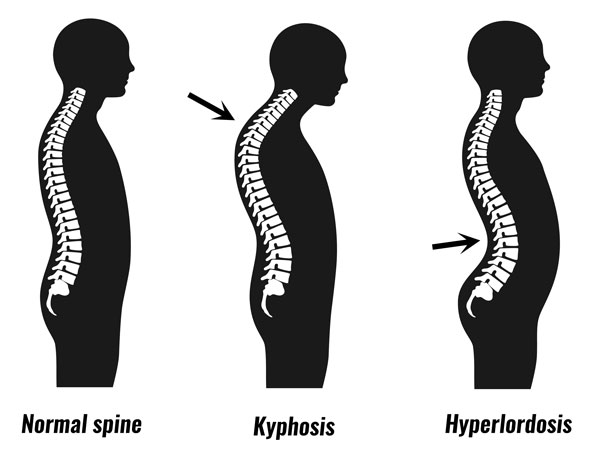Kyphosis is a condition that affects the spine and causes the back to curve forward. This can cause pain and discomfort, as well as limit mobility. There are several different causes of kyphosis, including age, genetics, and injury. In this blog post, we will discuss what is hyperkyphosis, as well as its various causes. We will also outline treatment options and ways to prevent this from developing.
Contents
What Is Hyperkyphosis?
 Hyperkyphosis, also known as dowager’s hump or hunchback, is a condition characterized by an excessive curve in the upper back. The condition can be painful and can lead to problems with mobility and balance. It is described as a forward rounding of the back at the thoracic spine, often causing the shoulders to appear hunched.
Hyperkyphosis, also known as dowager’s hump or hunchback, is a condition characterized by an excessive curve in the upper back. The condition can be painful and can lead to problems with mobility and balance. It is described as a forward rounding of the back at the thoracic spine, often causing the shoulders to appear hunched.
There are also some types where the curve is more pronounced and causes the head to be pushed forward, which can lead to difficulty breathing. For example, in Scheuermann’s kyphosis, the vertebrae fuse together during adolescence, which can cause the spine to curve excessively.
Therefore, if you are experiencing any of these symptoms, it is important to consult a doctor to rule out any serious underlying conditions.
How To Identify It?
Identifying a hyperkyphosis is difficult and often requires specialized medical imaging. An assessment by a healthcare professional is necessary to diagnose hyperkyphosis. There are a few common signs that may indicate a person has hyperkyphosis:
- A hump on the back, most often seen in the thoracic spine
- Excessive curvature of the spine when viewed from the side
- Poor posture
- Difficulty standing up straight
- Back pain
The feeling of hyperkyphosis can vary from person to person. Some people with mild hyperkyphosis may not experience any symptoms at all. For others, the condition can lead to pain and difficulty moving.
All in all, if you are having any of the above symptoms, it is best to consult a doctor and get an assessment done. Because if you ignore or don’t treat hyperkyphosis, it can lead to more serious problems such as:
- Compression fractures in the spine
- Decreased lung capacity
- Heart problems
- Osteoarthritis
- Degenerative disk disease
What Causes Hyperkyphosis?
 The exact cause of hyperkyphosis is often unknown. However, there are a few potential causes that have been identified:
The exact cause of hyperkyphosis is often unknown. However, there are a few potential causes that have been identified:
- Poor posture: This is the most common cause of hyperkyphosis. People who slouch or hunch forward when sitting or standing are more likely to develop this condition.
- Bone fractures: A break in the spine can cause the bones to heal in a curved position, leading to hyperkyphosis.
- Scoliosis: It is a condition that causes the spine to curve sideways. People with scoliosis are more likely to develop hyperkyphosis.
- Kyphosis: In this condition, it causes the spine to curve abnormally. And then it might be a risk factor to develop hyperkyphosis.
- Osteoporosis: This is a condition that causes the bones to become weak and fragile. People with osteoporosis are more likely to develop hyperkyphosis.
These causes are quite common but it is considered that there are a few risk factors that can make a person more likely to develop hyperkyphosis. These include:
- Age: The older a person is, the more likely they are to develop hyperkyphosis.
- Gender: Women are more likely to develop hyperkyphosis than men.
- Family history: People with a family history of hyperkyphosis are more likely to develop the condition.
Now, you have just learned about the causes as well as the risk factors of hyperkyphosis. It is important to seek medical help if you are experiencing any symptoms of this condition. Early diagnosis and treatment can help prevent the condition from getting worse.
How Is It Diagnosed?
A diagnosis of hyperkyphosis can be made based on a person’s medical history and a physical examination. An x-ray of the spine may also be ordered to assess the degree of curvature. There is a method called the Corset test that is sometimes used to help diagnose kyphosis. The test involves wearing a back brace for a period of time to see if symptoms improve.
If you have kyphosis, your spine will have an excessive curve when viewed from the side. The angle of the curve is measured using a tool called a Cobb angle. A Cobb angle of more than 50 degrees is considered to be indicative of kyphosis.
Therefore if you have a Cobb angle of more than 50 degrees, it is likely you will be diagnosed with kyphosis. On the other hand, the diagnosis of hyperkyphosis is made if the curve is greater than 80 degrees. So get an accurate diagnosis in order to get the right treatment.
How Can You Treat Hyperkyphosis?
 When you have hyperkyphosis, your spine curves excessively, causing rounding of your shoulders. This can lead to back pain, poor posture, and difficulty breathing. Hyperkyphosis is also known as dowager’s hump or hunchback.
When you have hyperkyphosis, your spine curves excessively, causing rounding of your shoulders. This can lead to back pain, poor posture, and difficulty breathing. Hyperkyphosis is also known as dowager’s hump or hunchback.
There are a number of possible treatments that can help you manage the condition and improve your quality of life. These include:
- Exercise: Regular exercise can help to strengthen the muscles around your spine and improve your posture. A physiotherapist or exercise coach can design an appropriate exercise program for you.
- Posture training: Learning how to correct your posture can help to ease pain and prevent further damage to your spine. A physiotherapist can teach you how to sit, stand, and sleep in positions that put less strain on your back.
- Bracing: In some cases, a brace may be recommended to support your spine and help improve your posture. Your doctor will be able to advise you if this is suitable for you.
- Pain relief medication: Over-the-counter painkillers such as ibuprofen or paracetamol can help to ease any pain caused by hyperkyphosis. Your doctor may also prescribe stronger medication if required.
- Injections: If other treatments are not effective, your doctor may recommend injections of steroids or other drugs into the affected area.
- Surgery: In severe cases of hyperkyphosis, surgery may be recommended to straighten the spine. This is usually only considered when other treatments have failed and the deformity is causing significant pain or disability.
Hyperkyphosis can be a debilitating condition, but there are a number of treatments that can help improve your symptoms and quality of life. If you are concerned about your spine or back pain, talk to your doctor for advice. With the right approach, you can still lead an active and fulfilling life despite hyperkyphosis.
Can It Be Prevented?
While hyperkyphosis can be seen in people of all ages, it is most common in older adults. The condition is also more prevalent in women than men. It is important to understand that prevention is not sometimes that can “cure” or “fix” hyperkyphosis, but rather it is something that may help to slow the progression of the condition. some simple preventative measures include:
- Maintaining good posture
- Avoiding slouching
- Using ergonomic furniture
- Exercising regularly
- Strengthening the back and shoulder muscles
While there is no cure for hyperkyphosis, treatment options are available that can help to improve the condition and alleviate pain. However, these prevention tips can help to keep the condition from worsening.
Hyperkyphosis is a condition that results in an excessive rounding of the spine. The condition can cause pain and may lead to difficulty performing everyday activities. While there is no cure for hyperkyphosis, treatment options are available that can help to improve the condition and alleviate pain.
So do not despair if you or a loved one has been diagnosed with this condition. There are things that can be done to help manage it. But, as always, prevention is the best medicine. Take steps to maintain good posture and strengthen back and shoulder muscles.
Conclusion
In conclusion, hyperkyphosis is a condition that results in an excessive curvature of the spine. The most common causes are poor posture and osteoporosis. Treatment typically involves exercises and stretches to improve posture and strengthen the back muscles. In severe cases, surgery may be necessary to correct the deformity.
Hyperkyphosis can cause pain and difficulty with activities of daily living. If you think you may have this condition, talk to your doctor. Early diagnosis and treatment can help improve your quality of life.
Physical Therapy help patients recover from pain. If you’re experiencing Back pain, Shoulder pain, Knee pain, Neck pain, Elbow pain, Hip pain, or Arthritis pain, a physical therapist at MantraCare can help: Book a physiotherapy session.


